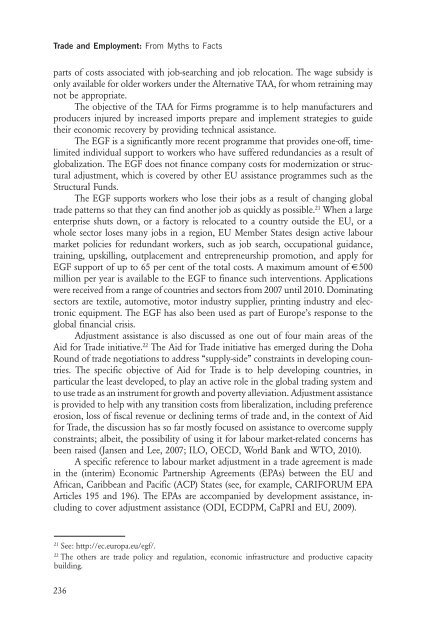Trade and Employment From Myths to Facts - International Labour ...
Trade and Employment From Myths to Facts - International Labour ...
Trade and Employment From Myths to Facts - International Labour ...
You also want an ePaper? Increase the reach of your titles
YUMPU automatically turns print PDFs into web optimized ePapers that Google loves.
<strong>Trade</strong> <strong>and</strong> <strong>Employment</strong>: <strong>From</strong> <strong>Myths</strong> <strong>to</strong> <strong>Facts</strong><br />
parts of costs associated with job-searching <strong>and</strong> job relocation. The wage subsidy is<br />
only available for older workers under the Alternative TAA, for whom retraining may<br />
not be appropriate.<br />
The objective of the TAA for Firms programme is <strong>to</strong> help manufacturers <strong>and</strong><br />
producers injured by increased imports prepare <strong>and</strong> implement strategies <strong>to</strong> guide<br />
their economic recovery by providing technical assistance.<br />
The EGF is a significantly more recent programme that provides one-off, timelimited<br />
individual support <strong>to</strong> workers who have suffered redundancies as a result of<br />
globalization. The EGF does not finance company costs for modernization or structural<br />
adjustment, which is covered by other EU assistance programmes such as the<br />
Structural Funds.<br />
The EGF supports workers who lose their jobs as a result of changing global<br />
trade patterns so that they can find another job as quickly as possible. 21 When a large<br />
enterprise shuts down, or a fac<strong>to</strong>ry is relocated <strong>to</strong> a country outside the EU, or a<br />
whole sec<strong>to</strong>r loses many jobs in a region, EU Member States design active labour<br />
market policies for redundant workers, such as job search, occupational guidance,<br />
training, upskilling, outplacement <strong>and</strong> entrepreneurship promotion, <strong>and</strong> apply for<br />
EGF support of up <strong>to</strong> 65 per cent of the <strong>to</strong>tal costs. A maximum amount of €500<br />
million per year is available <strong>to</strong> the EGF <strong>to</strong> finance such interventions. Applications<br />
were received from a range of countries <strong>and</strong> sec<strong>to</strong>rs from 2007 until 2010. Dominating<br />
sec<strong>to</strong>rs are textile, au<strong>to</strong>motive, mo<strong>to</strong>r industry supplier, printing industry <strong>and</strong> electronic<br />
equipment. The EGF has also been used as part of Europe’s response <strong>to</strong> the<br />
global financial crisis.<br />
Adjustment assistance is also discussed as one out of four main areas of the<br />
Aid for <strong>Trade</strong> initiative. 22 The Aid for <strong>Trade</strong> initiative has emerged during the Doha<br />
Round of trade negotiations <strong>to</strong> address “supply-side” constraints in developing countries.<br />
The specific objective of Aid for <strong>Trade</strong> is <strong>to</strong> help developing countries, in<br />
particular the least developed, <strong>to</strong> play an active role in the global trading system <strong>and</strong><br />
<strong>to</strong> use trade as an instrument for growth <strong>and</strong> poverty alleviation. Adjustment assistance<br />
is provided <strong>to</strong> help with any transition costs from liberalization, including preference<br />
erosion, loss of fiscal revenue or declining terms of trade <strong>and</strong>, in the context of Aid<br />
for <strong>Trade</strong>, the discussion has so far mostly focused on assistance <strong>to</strong> overcome supply<br />
constraints; albeit, the possibility of using it for labour market-related concerns has<br />
been raised (Jansen <strong>and</strong> Lee, 2007; ILO, OECD, World Bank <strong>and</strong> WTO, 2010).<br />
A specific reference <strong>to</strong> labour market adjustment in a trade agreement is made<br />
in the (interim) Economic Partnership Agreements (EPAs) between the EU <strong>and</strong><br />
African, Caribbean <strong>and</strong> Pacific (ACP) States (see, for example, CARIFORUM EPA<br />
Articles 195 <strong>and</strong> 196). The EPAs are accompanied by development assistance, including<br />
<strong>to</strong> cover adjustment assistance (ODI, ECDPM, CaPRI <strong>and</strong> EU, 2009).<br />
21 See: http://ec.europa.eu/egf/.<br />
22 The others are trade policy <strong>and</strong> regulation, economic infrastructure <strong>and</strong> productive capacity<br />
building.<br />
236

















